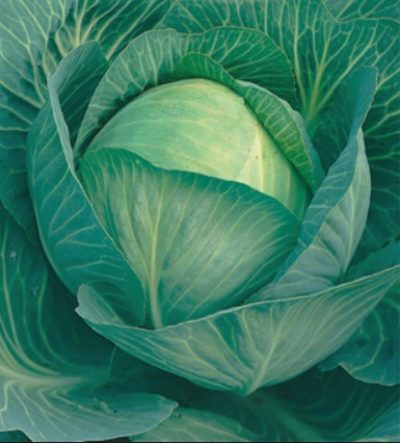
- Authors: Alekseev Yu.B.
- Year of approval: 2008
- Appointment: for fresh consumption, for fermentation, for freezing, for canning
- Leaf rosette: raised to horizontal
- Leaf size: medium size
- Leaf color: blue-green
- Sheet surface: slightly bubbly
- Outside stump: middle length
- Internal stump: short
- Weight, kg: 1,8-2,6
Gloria is a hybrid variety of white cabbage, bred by the Russian breeder Yu. B. Alekseev. The variety was approved for use in 2008. Over the years, the properties of Gloria cabbage have been well studied by summer residents, who shared their experience in growing this variety.
Description of the variety
This hybrid tolerates both cold and heat well, and therefore it is grown outdoors. Gloria is recommended to be cultivated in the Central and North Caucasus regions, as well as in the Central Black Earth Region. The fruits are distinguished by high marketability (96%) and excellent transportability, which is explained by the high density of heads of cabbage - 4.4 points.
This variety can be stored for a long time - up to 4 months, but it is worth noting its shortcomings, namely, its exactingness to the place of growth. Gloria prefers to grow in open, sunny areas. Also, this hybrid does not tolerate waterlogging well, so it is worth following certain watering rules.
Characteristics of the appearance of the plant and heads of cabbage
Gloria has a rosette of leaves raised to the horizontal, the leaves themselves are medium in size, blue-green, small bubbles and thin veins can be observed on the surface, the edges are wavy. The outer stump is of medium length, and the inner one is short. The weight of a head of cabbage usually reaches 1.8-2.6 kg, it is round in shape, green on the outside, whitish on the inside.
Purpose and taste
The texture is juicy, the taste is good, even excellent. Gloria can be eaten fresh, used for pickling and canning, added to soups, stewed, used as a filling for pies and pancakes.
Ripening terms
From germination to harvest, 75-80 days pass, which is typical for early varieties. Harvesting usually takes place in July-August, heads of cabbage are removed at the stage of technical ripeness.
Yield
This is a high-yielding variety that yields an average of 487-566 c / ha of cabbage.
Growing and care
The optimal time for sowing is March-April, young seedlings are transplanted to a summer cottage in May. When choosing a ridge, it is important to observe the crop rotation. So, cucumbers, potatoes, legumes will be good predecessors. It is worth avoiding areas where turnips, radishes, tomatoes, and other varieties of cabbage used to grow.
Gloria will feel more comfortable in the soil, which is flavored with peat, sand, ash and compost. The site must be located on the sunny side. Plant the bushes according to the 60x40 cm pattern.
In the first week, plants need to be moistened twice a day, and then watering once a week is enough. For irrigation, use settled warm water, preferably rainwater, and be sure to direct the stream to the root. It is important to carry out the procedure in the evening, since during this period the moisture will not evaporate and the sun will not leave burns on the leaves.
Top dressing will be required three times per season. The first fertilizer is applied in the spring, after planting, a mixture of urea, wood ash, superphosphate and water will be appropriate. The next feeding will be required in a couple of weeks, and now it is better to use nitrogen and organic compounds.The last time the culture is fertilized in about a month, and now a potassium-nitrogen mixture with the addition of superphosphate will be relevant.
Do not allow a crust to form on the ground, otherwise moisture and oxygen will not be able to fully penetrate to the roots, which will affect the quality of the crop. To do this, loosen the soil at least once a week after watering.

To grow a rich cabbage crop, you need to know when and how to plant this crop outdoors. Planting dates are determined depending on the variety. It is also necessary to properly prepare the soil and follow the rules of crop rotation.



Cabbage requires particularly careful care when growing. The plant quickly absorbs nutrients, so the soil needs to be enriched regularly. Adequate amounts of minerals, organics and nitrogen must be provided. Some products can be purchased at the store, while others are easy to make at home.
Disease and pest resistance
Gloria has a high immunity to cracking and fusarium wilt, but can be affected by other diseases. To prevent ailments, you should always disinfect the tools when working with the plant, and also treat the seedlings with the "Fitosporin" solution at the planting stage. It is important to stop using Fitosporin when the head of cabbage appears.
Insects can also become enemies of gloria, for example, aphids, caterpillars, and scoops. Mint, cilantro and rosemary planted between the rows will help scare off these individuals - insects cannot stand their smell. Also, for pest control, you can use an infusion of onion peel or tomato tops.

Cabbage is a very popular horticultural crop. But growing a good, large and tasty cabbage is sometimes very difficult, because it is often affected by a huge number of diseases and pests. The main role in the cultivation of this vegetable is played by regular prevention, which helps to get a rich harvest, and prevent the occurrence of diseases and the invasion of harmful insects. It is very important to start treatment as early as possible, otherwise there is a risk of spreading the infection to still unaffected plants.























































































